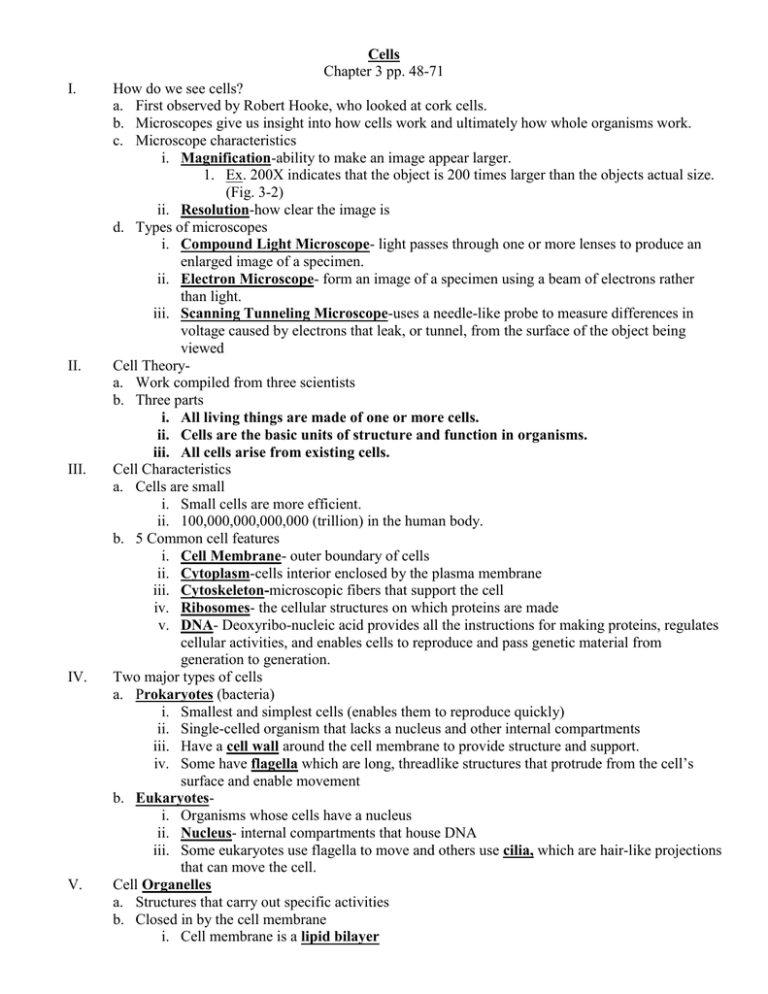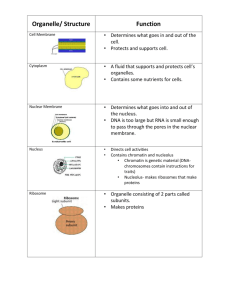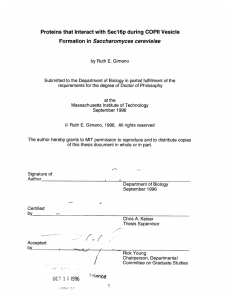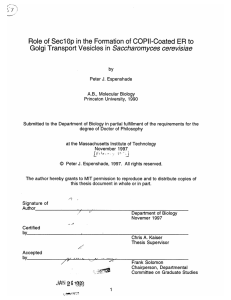Cells Chapter 3 pp. 48-71 I. How do we see cells?
advertisement

Cells Chapter 3 pp. 48-71 I. II. III. IV. V. How do we see cells? a. First observed by Robert Hooke, who looked at cork cells. b. Microscopes give us insight into how cells work and ultimately how whole organisms work. c. Microscope characteristics i. Magnification-ability to make an image appear larger. 1. Ex. 200X indicates that the object is 200 times larger than the objects actual size. (Fig. 3-2) ii. Resolution-how clear the image is d. Types of microscopes i. Compound Light Microscope- light passes through one or more lenses to produce an enlarged image of a specimen. ii. Electron Microscope- form an image of a specimen using a beam of electrons rather than light. iii. Scanning Tunneling Microscope-uses a needle-like probe to measure differences in voltage caused by electrons that leak, or tunnel, from the surface of the object being viewed Cell Theorya. Work compiled from three scientists b. Three parts i. All living things are made of one or more cells. ii. Cells are the basic units of structure and function in organisms. iii. All cells arise from existing cells. Cell Characteristics a. Cells are small i. Small cells are more efficient. ii. 100,000,000,000,000 (trillion) in the human body. b. 5 Common cell features i. Cell Membrane- outer boundary of cells ii. Cytoplasm-cells interior enclosed by the plasma membrane iii. Cytoskeleton-microscopic fibers that support the cell iv. Ribosomes- the cellular structures on which proteins are made v. DNA- Deoxyribo-nucleic acid provides all the instructions for making proteins, regulates cellular activities, and enables cells to reproduce and pass genetic material from generation to generation. Two major types of cells a. Prokaryotes (bacteria) i. Smallest and simplest cells (enables them to reproduce quickly) ii. Single-celled organism that lacks a nucleus and other internal compartments iii. Have a cell wall around the cell membrane to provide structure and support. iv. Some have flagella which are long, threadlike structures that protrude from the cell’s surface and enable movement b. Eukaryotesi. Organisms whose cells have a nucleus ii. Nucleus- internal compartments that house DNA iii. Some eukaryotes use flagella to move and others use cilia, which are hair-like projections that can move the cell. Cell Organelles a. Structures that carry out specific activities b. Closed in by the cell membrane i. Cell membrane is a lipid bilayer VI. VII. 1. Fig.3-9 c. Endoplasmic reticulum- (ER) move proteins and other substances through the cell i. Rough Endoplasmic Reticulum- ER with ribosomes attached 1. transports proteins d. Vesiclei. A small membrane bound sac that transports substances in cells ii. Pinches off the ER e. Golgi apparatusi. A set of flattened, membrane-bound sacs that serves as a packaging plant f. Lysosomesi. A special kind of vesicle. ii. Small, spherical organelles that contain the cell’s digestive enzymes g. Centrioles i. Function in cell division anchor the spindle fibers which separate chromosomes h. Mitochondriai. The power house of the cell ii. Makes ATP (the main energy currency of cells) iii. Contain there own DNA and ribosomes i. Plant cells have some Organelles that Animal cells don’t i. Chloroplasts-use light energy to make carbohydrates from carbon dioxide and water ii. Central vacuole-contains many substances including water and nutrients. 1. When it is full it pushes against the rest of the cell making the cell rigid which makes the plant stand up. iii. Cell Wall-surrounds the cell membrane in plant cells 1. Does not prevent the movement of substances across the cell membrane. 2. Connects cells to adjacent cells 3. Contains cellulose Production of Proteins 1. Ribosomes make proteins on the rough ER. The proteins are packed into vesicles 2. Vesicles take the proteins to the Golgi apparatus to be processed. 3. Proteins are processed in the Golgi apparatus and packed into new vesicles. 4. Many vesicles are moved to the cell membrane and release their contents outside the cell. 5. Other vesicles stay in the cell to perform functions. Cellular Transporta. Cells want to keep a state of homeostasis, which is the maintenance of internal conditions in spite of changes in the external environment. b. Do this by transporting materials in different ways. c. Passive Transport-does not require energy from the cell to move materials i. Concentration gradient-the difference in concentration of a substance across a space. Passive transport- molecules move with concentration gradient ii. Equilibrium-concentration of a substance is equal throughout a space. iii. Diffusion-movement of a substance from high concentration to low concentration. iv. Osmosis-diffusion of water 1. hypertonic-water moves out 2. hypotonic-water moves in 3. isotonic-no net water movement v. Ion Channel-doughnut shaped transport protein through which ions travel vi. Facilitated diffusion-passive transport of materials down their concentration gradient using the help of a carrier protein. 1. Carrier Protein-a protein that can bind to a substance and carry it across the cell membrane d. Active Transport-requires the cell to use energy (ATP) to transport materials i. Transport against the concentration gradient ii. Sodium Potassium pump1. Transports 3 sodium ions out of a cell and 2 potassium ions into the cell iii. Endocytosis- movement of a substance into a cell by a vesicle iv. Exocytosis-movement of a substance out of a cell by a vesicle v. Receptor Proteins- a protein that binds to a specific signal molecule, enabling the cell to respond to the signal molecule







